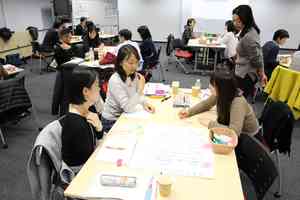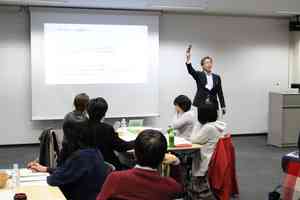March 11, 2019
“Interactive Teaching” Academy: Part 7 “Microteaching Clinic”
| Tag |
|---|
Here is a brief report of our latest event and a preview of our next event.
“Interactive Teaching” Academy: Part 7 “Microteaching Clinic”
Date/Time: March 2nd (Sat), 2018, 13:00–18:00; March 3rd (Sun), 2018, 10:00–17:00
Venue: 93B, 92B, Faculty of Engineering Building 2, Hongo Campus
Participants: 32 people (Five of them conducted microteaching sessions.)
Instructors: Kayoko Kurita (Center for Research and Development of Higher Education, The University of Tokyo)
Lui Yoshida (College of Arts and Sciences, The University of Tokyo)
Masaru Sekido (National Institute of Technology, Sendai College / Center for Research and Development of Higher Education, The University of Tokyo)
Nagafumi Nakamura (Center for Research and Development of Higher Education, The University of Tokyo)
1. Topic and Goal
This time, the topic was “Microteaching.” Based on the goal, “Be able to conduct classes that promote student learning,” we set specific learning objectives as follows:
① Understand and be able to utilize “Learning Sciences” (e.g., motivation) in class design. (Preparation)
② Be able to explain the perspectives that you should be careful of when conducting classes through refining others’ microteaching sessions. (Sessions)
③ Be able to utilize the refinement of your microteaching session in your future practice. (Sessions) *③ was an objective for those who conducted microteaching sessions.
2. Summary
This program was conducted in a flipped-classroom manner, and participants worked on pre-class assignments beforehand. They conducted and examined microteaching sessions based on their preparation.
(1) Preparation
All participants were asked to learn about “Learning Sciences” by watching the videos for WEEK 3 of “Interactive Teaching” and reading Chapter 3 of the book “Interactive Teaching” (Kawai Publishing, 2017). This was because it is important to understand theories related to enhancing motivation when you conduct classes that promote learning. Also, those who were in charge of conducting microteaching sessions were asked to submit class design sheets and handouts beforehand.
(2) Sessions
<DAY 1>
[1] Introduction (13:00–13:15)
Participants listened to the explanation of the goals, structure, and rules of the program before introducing themselves to others. They consisted of five lecturers of microteaching sessions and 26 observers who took their lectures.
[2] Microteaching Session & Examination 1 (13:15–16:15)
Participants first reviewed the significance of conducting and examining microteaching sessions. Then the first lecturer gave a mini-lecture. Then, they were divided into two groups and moved to separate classrooms. The second lecturers conducted lectures in their respective rooms. Following their 10-minute lectures, the participants exchanged their ideas on what was good about the lectures, what points needed improvement, and how they could be improved in groups and the whole classroom in 40 minutes.
[3] Refining Microteaching Sessions (Lecturers) / What You Can Learn from Microteaching Sessions (Observers) (16:35–17:45)
Participants worked on activities in two separate classrooms.
Those who conducted microteaching sessions worked on improving their lectures based on the feedback they had received from observers in the first trial.
Meanwhile, observers shared in groups what they had learned from the first trial of microteaching sessions from the following two perspectives: “design contents” and “delivery.” Then, they shared their ideas with the whole participants through a poster tour. This activity was to help them generalize what they had learned from the microteaching sessions so that they can utilize it to improve their own classes.
<DAY 2>
[4] Microteaching Session and Examination 2 (10:00–15:10)
All five lecturers conducted their second-time lectures, which were improved based on the feedback they had received on the first trial, in the same classroom this time. Each 10-min lecture was followed by a 20-min discussion, where they exchanged their ideas on what was excellent about the lecture, what points were improved, what points still needed improvement, and how they could be improved. The observers were able to examine the lecture from various perspectives since they consisted of both who took the lecture for the first time and the second time.
[5] Microteaching as a Faculty Development Program (15:10–16:20)
Participants examined in groups what organizers, lecturers of microteaching sessions, and observers should prepare themselves and try to do to make microteaching significant as an FD program. This activity helped them examine what they should be careful of when conducting microteaching in their own learning environment and propose what we should do to improve microteaching in this event.
[6] Wrap-up (16:30–17:00)
Lastly, participants organized what they learned, what kind of questions they had, and what they wanted to bring back to their own work through group activities and Q&A sessions.

Participants learning from each other ([5] Microteaching as an FD Program)
3. Participants’ Reactions
The affiliation of 32 participants was as follows: 12 faculty or staff members of the university or technical college, 12 graduate students or postdocs, four teachers or staff members of junior/senior high school, one teacher or staff member of elementary school, two teachers or staff members of vocational school, and one company employee. According to the five-point scale question asking the degree of satisfaction (Extremely satisfied; Very satisfied; Satisfied; Not so satisfied; Dissatisfied), 44 percent of the respondents were “extremely satisfied,” 52 percent were “very satisfied,” and 4 percent were “satisfied.”
According to another five-point scale question asking whether participation in the program would affect your future practice (Yes (very much); Yes; No (not so much); No (not at all); Unsure), 25 percent of the respondents answered “Yes (very much),” 67 percent answered “Yes,” and 8 percent answered, “No (not so much).”
Here are some of the feedback we received in the comment section:
- “I was able to deepen my understanding through the structure of the program that proceeded in the order of the first microteaching session, improvement of lectures, and the second microteaching session.” (Lecturer of the microteaching sessions)
- “There was a lecturer who made a remarkable improvement in his/her lecture on the second day, which offered me a specific example of improving the class design.” (Observer of the microteaching sessions)
- “The program gave me a lot of practical tips on how to improve my classes. I will revise my class design materials for the next academic year as soon as I get home today.” (Observer of the microteaching sessions)
4. Preview of the Next Program
We are planning to organize a more systematic program for the next academic year. Details are to be announced. We look forward to your participation.
References
Videos “Interactive Teaching” JREC-IN website UTokyo FD website
Book “Interactive Teaching” (Kawai Publishing, 2017)
https://www.kawai-publishing.jp/book/?isbn=978-4-7772-1794-6 (Kawai Publishing website)
Nagafumi Nakamura (Project Researcher in charge of “Interactive Teaching” / Main Moderator of this event)

